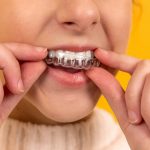
The increase availability and use of clear aligner therapy for orthodontic treatment has resulted in lead to a rise in the number of adults undertaking orthodontic treatment. However, orthodontic treatment may have an adverse effect on periodontal health and result in while spot lesions. While these may resolve following active treatment they may persist. The ability to remove clear aligners to allow a normal oral health routine to prevent or reduce adverse effect is considered to be a benefit although some studies have suggested no difference.
The aim of this review was to compare plaque accumulation in orthodontic patients undergoing clear aligner and conventional fixed appliance treatment.
Methods
A protocol was registered with the Open Science Framework Registries. Searches were conducted in the PubMed, Embase, Scopus, Google Scholar Opengrey, Proquest Dissertation Abstracts and Thesis database and ClinicalTrials.gov databases. Two reviewers independently screened and selected studies and extracted data. Risk of bias was assessed with the Cochrane risk-of-bias tool (ROB 2) for randomised controlled trials (RCTs) and the ROBINS-I tool for non-randomised studies(NRS). Standardised mean differences (SMD) and 95% confidence intervals (CIs) were used as summary measures for plaque index.
Results
- 14 studies (5 RCTs, 9 NRS) were included.
- 8 studies assessed plaque outcomes, 4 assessed white spot lesions (WSL) and 2 assessed salivary caries-associated bacteria and plaque accumulation.
- All 5 RCTs and 3 NRS were considered to be at high risk of bias, with 6 NRS at moderate risk of bias.
- 8 studies (3 RCTs, 5 NRS) contributed to a meta-analysis of plaque accumulation indicating less plaque accumulation with clear aligner use, SMD = −1.58 (95% CI: -2.57 to -0.58).
- Both studies reporting on caries- associated bacteria reported high concentrations with conventional appliance.
- 3 of the 4 studies reporting on WSL reported less risk with clear aligner therapy.
- The authors rated the certainty of evidence for plaque accumulation as moderate.
Conclusions
The authors concluded: –
moderate-quality evidence reveals less plaque accumulation and less salivary caries-associated bacteria in clear aligners (CA), which might be related to the reduced incidence and severity of WSLs associated with CA when compared with CF appliances. However, the results of the present study should be interpreted with caution given the high risk of bias among some of the included studies as well as the marked heterogeneity across the studies.
Comments
The authors registered their protocol on the Open Science Framework registry and undertook a search on a wide range of databases including 14 studies. Previously we have looked at two other reviews that have looked at the impact of clear aligners on periodontal health (Dental Elf – 13th Jan 2015, Dental Elf – 29th March 2023) and while the reviews have shown an increase in the number of included studies the quality of the included studies has not improved with most studies being at high risk of bias. While the two most recent reviews have suggested that CA may have some benefits for periodontal health the low quality of the available evidence means that these findings should be viewed cautiously. Well conducted and reported high quality prospective studies of appropriate size and duration using agreed common outcome sets (COMET) are needed to provide better evidence on this question.
Links
Primary Paper
Raghavan S, Abu Alhaija ES, Duggal MS, Narasimhan S, Al-Maweri SA. White spot lesions, plaque accumulation and salivary caries-associated bacteria in clear aligners compared to fixed orthodontic treatment. A systematic review and meta- analysis. BMC Oral Health. 2023 Aug 27;23(1):599. doi: 10.1186/s12903-023-03257-8. PMID: 37635207; PMCID: PMC10463770.
Review protocol in Open Science Framework Registry
Other references
Dental Elf – 29th March 2023
Dental Elf – 13th Jan 2015
Dental Elf – Clear Aligner Therapy Blogs
Picture Credits
Photo by Diana Polekhina on Unsplash
